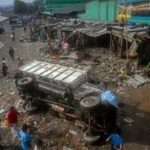Rescue teams in Nepal’s capital are searching through destroyed homes on Monday following monsoon floods that have claimed the lives of at least 209 people in the Himalayan republic.
During the monsoon season from June to September, deadly floods and landslides are common across South Asia. Experts suggest that climate change is exacerbating these disasters.
In Kathmandu, entire neighborhoods were submerged after the heaviest rainfall in over two decades. The capital was temporarily isolated from the rest of Nepal due to landslides blocking highways.
The Home Ministry of Nepal reported that 209 people have died across the country, with 29 individuals still missing. Aerial rescue efforts have been intensified to assist those in need of medical help or rescue.
Police stated that at least 35 people were buried alive by a landslide that struck vehicles on a highway south of Kathmandu.
Bulldozers are being used to clear debris blocking major roads leading into Kathmandu, and efforts are underway to rescue people stranded on highways.
Over 400 individuals were rescued from various districts on Monday, with rescuers working tirelessly to clear mud from the worst-hit areas around Kathmandu.
The International Centre for Integrated Mountain Development (ICIMOD) attributed the severity of the disaster to unplanned urban development around the Bagmati River.
The army of Nepal reported over 4,000 rescues, utilizing helicopters, motorboats, and rafts to bring stranded individuals to safety.
According to Nilkantha Pandey of CARE Nepal, many flood victims are in need of safe drinking water and temporary housing, particularly those in informal settlements.
– ‘An extreme event’ –
Local merchants reported a severe reduction in the supply of fresh produce to Kathmandu due to road damage that blocked intercity transport.
Nepal’s weather bureau recorded record-breaking rainfall, with Kathmandu airport measuring about 240 millimeters of rain in a 24-hour period.
Arun Bhakta Shrestha of ICIMOD suggested that the abnormal rainfall and its impact could be attributed to climate change and unplanned urban development.
The monsoon season is crucial for agriculture and food production in South Asia, but it also brings devastating floods and landslides. Experts warn that climate change has intensified these disasters, with over 300 rain-related deaths reported in Nepal this year.
pm/gle/sn




